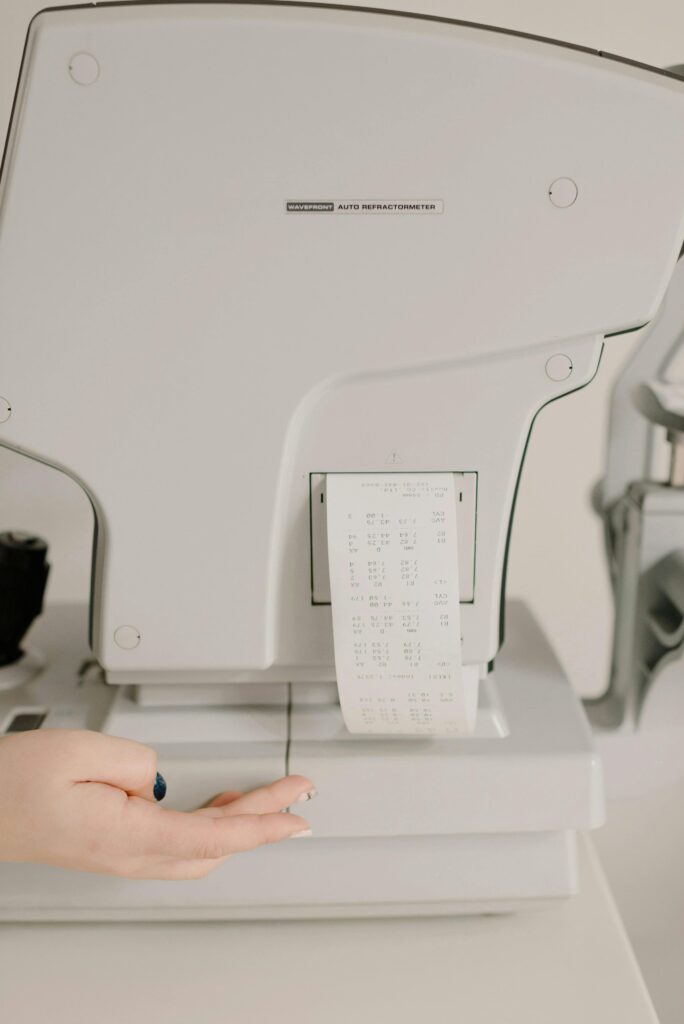Optical terminology is not something that we think about everyday. Whether you’re buying glasses, trying contact lenses, or just had an eye exam, you’ve probably heard terms like “astigmatism,” “PD,” or “progressive lenses” tossed around. But what do they all actually mean?
This glossary breaks down 50+ common optical terminology in simple, everyday language. We’ve also added helpful visual descriptions to give you a clearer picture (literally). And if you still have questions, don’t worry—Malaya Optical’s experienced optometrists are always ready to explain things in person. Just book an appointment and we’ll guide you every step of the way.
A-Z Optical Terms (Simplified and Explained)

1. Acuity (Visual Acuity)
How clearly you can see. It’s usually measured by reading letters on an eye chart. If you’ve ever heard someone say “20/20 vision,” they’re talking about acuity.
Visual example: Imagine trying to read a sign from across the street—someone with 20/20 vision can read it clearly, but someone with lower acuity may see it as blurry.
2. Add (Addition)
Extra magnifying power added to the lower part of multifocal lenses to help you see up close—mostly used for reading or near tasks.
3. Astigmatism
A common condition where your cornea or lens is shaped more like a rugby ball than a football, causing blurry or distorted vision at all distances.
Visual example: Lights may look streaky or fuzzy, especially at night.
4. Axis
In a prescription for astigmatism, this is the angle (measured in degrees) that tells the lens how to position the correcting cylinder.
5. Bifocals
Lenses with two sections—one for distance and one for near vision. There’s usually a visible line separating the two.
6. Blue Light
Short-wavelength light emitted by digital screens, LEDs, and the sun. Extended exposure may cause eye strain.
Tip: Blue light-blocking lenses are available to reduce digital fatigue.
7. Cataract
Clouding of the natural lens in the eye, usually related to aging. It makes vision dull or blurry.
Visual example: Like looking through a fogged-up window.
8. Cylinder (CYL)
Part of a prescription that corrects astigmatism. It shows how much lens power you need to fix uneven curvature in the eye.
9. Depth Perception
Your ability to judge distances and see in 3D. This requires both eyes working together properly.
10. Diopter (D)
The unit used to measure the focusing power of lenses. A higher number means stronger correction.
Visualizing the Terms: What It Feels Like to See with Certain Conditions
- Myopia (Nearsightedness): You can see your phone clearly but the TV across the room is a blur.
- Hyperopia (Farsightedness): Reading a book is tough, but road signs are sharp.
- Presbyopia: Holding a menu at arm’s length because it’s blurry up close.
- Astigmatism: Streetlights may look like starbursts or have halos at night.
Talking to Your Optometrist: A Quick Guide
Feeling unsure about your prescription or diagnosis within this optical terminology? Here’s how to make your next visit more productive:
- Be Honest: Tell them about symptoms—even ones you think are small, like dry eyes or squinting.
- Ask Questions: Don’t hesitate to say, “What does that mean?” Your optometrist is there to help.
- Bring Your Glasses: If you’re getting new ones, bring your current pair for comparison.
- Mention Lifestyle Needs: Let them know if you use screens all day, drive at night, or play sports. This helps in recommending the right lenses.
Still Have Questions?
We know optical terms can be confusing at first—but that’s why we’re here. If you’d like a professional to walk you through your prescription, lens options, or any eye care concern, just visit Malaya Optical and book an appointment with one of our qualified optometrists. We’re happy to help you see better and feel more confident with your eyewear choices.


